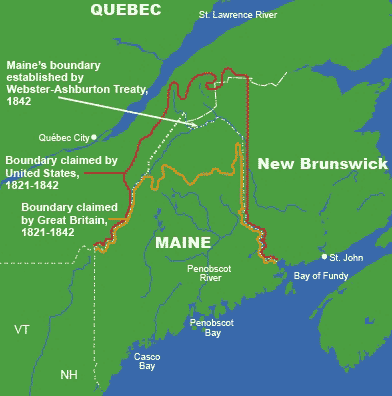The Aroostook War
The Treaty of Paris in 1783 left unresolved the boundary between Maine and its Canadian neighbors, New Brunswick and Lower Canada (Quebec). When Maine became a state in 1820 and began granting land to settlers in the Aroostook Valley, disregarding British claims, the situation became more antagonistic. The king of the Netherlands was asked to arbitrate the dispute, but although the British accepted his decision, the Americans rejected it.
Canadian lumberjacks arrived in the Aroostook area during the winter of 1838-1839 in order to cut timber. In February, they seized the American land agent whose job had been to force them out.

Under pressure from Maine, the U.S. Congress authorized a force of 50,000 men and appropriated ten million dollars to address the crisis. Maine raised forces for the anticipated fight and actually sent 10,000 troops into the disputed Aroostook Valley region, but General
Winfield Scott arrived and pursuaded the Maine and New Brunswick authorities to agree to submit the matter to a commission. The matter was eventually resolved in the
Webster-Ashburton Treaty of 1842.
The Aroostook War was an undeclared and bloodless conflict which heightened tensions between Britain and the United States. Some elements were critical of President
Van Buren for not taking stronger and more immediate action against the former mother country.
